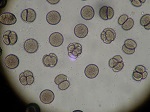
Synthetic embryos - those two words just don't seem to go together. And yet two separate studies accomplished this feat. Even though both studies worked with mouse cells, it's remarkable that the researchers began with single cells and then saw them grow into embryos.
One group of researchers used stem cells that were manipulated to possess the ability to become any cell in a mouse body. From there, certain genes were switched on to lead some cells to form the mouse placenta. Other cells were treated to activate genes that would form either the yolk sac which provides nutrition to the embryo or then to form the embryo itself.
In the other study, scientists started with cells destined to become the yolk sac, placenta or the embryo itself. Then the cells were continuously bathed in nutrients and encouraged to interact which is the key.
As the cells grew, chemicals were exchanged between the different cells that signaled to one another to continue to develop into the cells they were meant to be. Over the more than eight days of development, recognizable features of the embryo developed.
They grew a beating heart, formed a digestive tract, and began to assemble a central nervous system with a forebrain and a mid-brain. Incredible. After the eighth day, the embryos died. Researchers are looking into why. Perhaps it needed signaling from the mother's tissues that weren't in the lab environment. Still it's remarkable that the embryos highly resembled natural embryos from mouse mothers at that stage of development.
What we learn from this could shed light on the very complex study of human fetal development.
More Information
Lab-made mouse embryos grew brains and beating hearts, just like the real thing
Scientists coaxed mouse stem cells to grow into synthetic embryos that began developing hearts and brains, just like the real thing.The lab-made embryos, crafted without any eggs or sperm and incubated in a device that resembles a fast-spinning Ferris wheel full of tiny glass vials, survived for 8.5 days. That's nearly half the length of a typical mouse pregnancy...
Post-gastrulation synthetic embryos generated ex utero from mouse naive ESCs
n vitro cultured stem cells with distinct developmental capacities can contribute to embryonic or extraembryonic tissues after microinjection into pre-implantation mammalian embryos. However, whether cultured stem cells can independently give rise to entire gastrulating embryo-like structures with embryonic and extraembryonic compartments remains unknown...